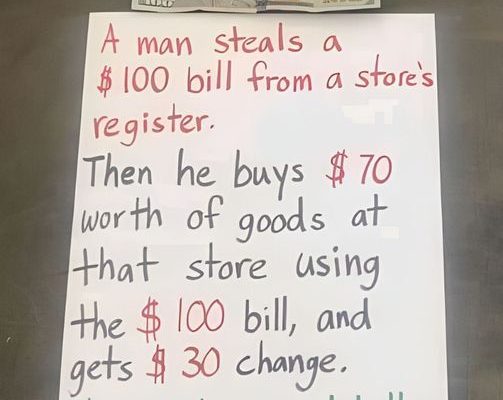
The brain teaser, originally shared on X (formerly Twitter) by the account Out of Context Human Race, presents a seemingly simple scenario. A man walks into a store, steals a $100 bill from the cash register, and then uses that same bill to buy $70 worth of goods. After the transaction, the thief walks away with $30 in change. The question is then posed: “How much money did the store lose?”
As the puzzle made its rounds on the internet, it sparked a flurry of responses, with people confidently asserting different answers. Some insisted that the store’s total loss was $100, while others argued that the real loss was $130—factoring in both the stolen $100 and the $30 in change. A few even ventured into more complex territory, suggesting that the store’s actual loss depended on the profit margins of the goods sold.
To solve this brain teaser, one must carefully dissect the scenario. At first glance, it might seem logical to conclude that the store lost $100 due to the theft. However, the situation is a bit more nuanced. When the thief used the stolen $100 bill to make a purchase, the store effectively regained the $100. But then, the store handed over $30 in change, leading to a net cash loss of $30.
But that’s not the end of the story. The store also lost the $70 worth of goods that the thief purchased. Therefore, when you add the $30 in lost cash to the $70 in lost merchandise, the total loss for the store amounts to $100.
This $100 brain teaser is a brilliant example of how a seemingly simple problem can become the center of intense analysis and debate. It highlights the importance of considering all the details and nuances of a scenario rather than relying solely on initial gut reactions.
Moreover, this puzzle is a testament to the internet’s power to amplify and spread engaging content. Its widespread popularity showcases the public’s endless fascination with thought-provoking challenges that stimulate critical thinking and spark lively discussions.
Ultimately, the $100 brain teaser underscores our innate love for problem-solving and the satisfaction that comes from cracking a complex puzzle. As we navigate the fast-paced world of digital content, it’s essential to maintain a curious and analytical mindset, always ready to dig deeper and uncover the underlying truths.
So, the next time you encounter a tricky brain teaser, embrace the challenge, engage your critical thinking skills, and enjoy the process of figuring it out. Who knows—you might be the one to solve the next viral puzzle that takes the internet by storm.



